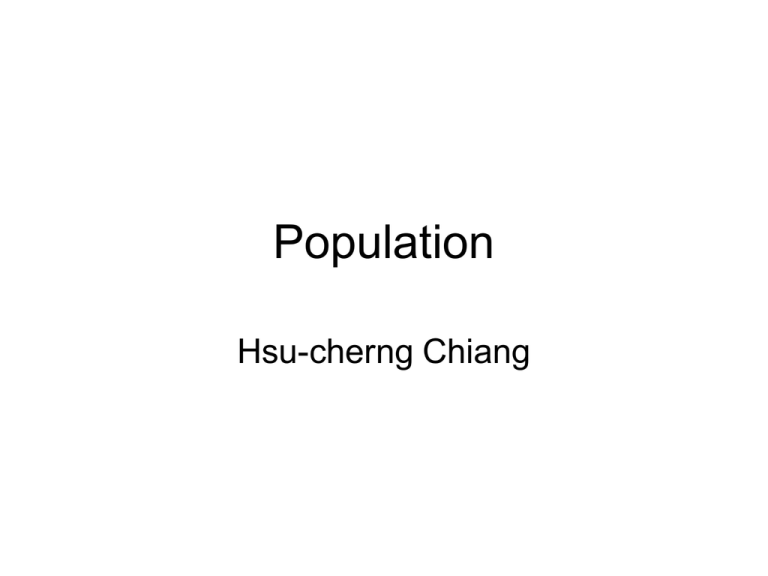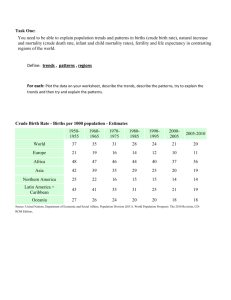
Population
Hsu-cherng Chiang
While modern humans are generally believed to have been around for over 100 000 years, it is
only in the past 10 000 years that total global population is believed to have ever exceeded a few
million people - roughly the population of Madrid, Spain or Nairobi, Kenya (Kremer 1993). After the
end of the Last Glacial Maximum (~10,000 BCE), population growth started to accelerate, doubling
every 600 to 1000 years between 3000 BCE and 1000 AD. By 1800, it was growing fast enough to
double in just one hundred years. Between 1959 and 2000 the Earth's population doubled in just
40 years! By one estimate, the number of new mouths to feed each year peaked in 1989 at around 87
million (roughly the equivalent of Ethiopia's current population). In 2010, the planet was still
adding 1 million people every 4.8 days (US Census Bureau 2011).
Source: http://na.unep.net/geas/newsletter/images/Jun_11/Figure1.png
人口數
•
•
•
•
•
•
世界人口(1650年) – 5億
世界人口(1820年) – 10億
世界人口(1930年) – 20億
世界人口(2011年9月) – 69億 6229萬
台灣人口(2011年4月) – 2317萬
台灣人口密度: 每平方公里639.7人
人口大量增加的環境問題
• 人數 X 每人使用資源數量 X 單位資源使用量對環境的影
響 = 環境影響
• 在人為控制下大量物質非閉合的輸入輸出
• 資源的消耗超過資源本身及其替代品生產的速度
• 污染物大量排放超過自淨能力
• 古者丈夫不耕,草木之實足食也;婦人不織,禽獸之皮足
衣也。不事力而養足,人民少而財有餘,故民不爭。是以
厚賞不行,重罰不用,而民自治。今人有五子不為多,子
又有五子,大父未死而有二十五孫。是以人民眾而貨財寡,
力勞而供養薄,故民爭,雖倍賞累罰而不免於亂。 <<韓
非子>>
Environmental Impact
Source:Miller, G.T., Sustaining the Earth: An Integrated Approach, 7th ed.
The world population is expected to keep on rising during the 21st century, although its growth is
projected to experience a marked deceleration during the second half of the century.
Source: United Nations, Department of Economic and Social Affairs, Population Division (2011): World Population Prospects:
The 2010 Revision. New York
A chart of changes in world population growth rate from 1950–2010 (red) and predicted changes in world population
growth rate from 2010–2050 (blue). The original was created 6 Dec 2003 by Securiger from data provided by the U.S.
Census Bureau. (Source: http://en.wikipedia.org/wiki/World_population)
Asia will remain the most populous major area in the world during the 21st century but Africa will
gain ground as its population more than triples, passing from 1 billion in 2011 to 3.6 billion in 2100.
Source: United Nations, Department of Economic and Social Affairs, Population Division (2011): World Population
Prospects: The 2010 Revision. New York
Source: http://na.unep.net/geas/newsletter/images/Jun_11/Figure4.png
Distribution of the world population by major area, medium variant,
1950, 2010, 2050 and 2100
Source: United Nations, Department of Economic and Social Affairs, Population Division (2011): World Population
Prospects: The 2010 Revision. New York
Source: http://www.un.org/esa/population/publications/wpp2006/wpp2006.htm
Population of the 20 most populous countries in 2010 and 2050 (millions)
2010
2050
Source: United Nations, Department of Economic and Social Affairs, Population Division (2011): World Population Prospects:
The 2010 Revision. New York
The population of the world will be older
世界人口正在加速老化
Globally, the number of persons aged 60 years or over is expected nearly to triple,
increasing from 673 million in 2005 to 2 billion by 2050.
http://www.un.org/esa/population/publications/wpp2006/wpp2006.htm
Population by age
groups and sex
(percentage of total
population)
Source: United Nations, Department of Economic and Social Affairs, Population Division (2011): World Population Prospects: The 2010 Revision.
台灣重要人口統計指標
年別
1989
1993
1999
2005
2006
2007
2008
2009
自然 社會
三階段人口結構 (%)
出生數 死亡數 增加數 增加數
15-64 65歲以
0-14歲
(千人)
(千人)
(千人)(千人)
歲
上
315
103
212
-10
27.5
66.5
6.0
326
111
215
-22
25.1
67.8
7.1
284
126
158
6
21.4
70.1
8.4
206
139
66
15
18.7
71.6
9.7
204
136
69
38
18.1
71.9
10.0
204
141
63
19
17.6
72.2
10.2
199
144
55
24
17.0
72.6
10.4
191
144
48
35
16.3
73.0
10.6
由於出生人數減少、死亡人數增加,我國人口自然增加人數持續遞減,惟受外籍配偶增加而使社會增
加人數隨之遞增的影響,近年來我國總人口每年仍約增加7-8萬人。
由於預期壽命延長,若社會中每一代出生數比上一代少,這個社會的人口就會逐漸高齡化;因此,我
國0-14歲人口比率持續下降,而65歲以上人口比率持續上升,人口高齡化程度愈來愈明顯。
Source: http://www.cepd.gov.tw/m1.aspx?sNo=0000455
16
台灣2010年及2060年人口金字塔(中推計結果)
– 2010年人口金字塔為中間大、兩頭小之燈籠形,代表勞動力供給充沛。
– 2060年人口金字塔將轉變為上寬下窄之倒金鐘型態,社會負擔相對較重。
男性
2060年
2010年
250
150
100 歲
90
80
70
60
50
40
30
20
10
0
50 千人 50
女性
150
250
17
Some Sobering Facts
• One-fifth of the world’s population live on
less than $1/day
• 1.5 billion lack access to clean water
• 2.4 billion lack access to sanitary facilities
• 790 million are malnourished
• Environmental degradation is rampant
• Fertility rates highest in poorest countries
Millennium Development Goals
•
•
•
•
•
•
•
•
Eradicate extreme poverty and hunger
Achieve universal primary education
Promote gender equality and empower women
Reduce child mortality
Improve maternal health
Combat HIV/AIDS, malaria, and other diseases
Ensure environmental sustainability
Forge a global partnership for development
Link: http://www.un.org/millenniumgoals/
http://en.wikipedia.org/wiki/Millennium_Development_Goals
Source: http://na.unep.net/geas/newsletter/images/Jun_11/Figure6a.png
Urban Agglomerations in 2009 (proportion urban of the world: 50.1%)
Source: United Nations, Department of Economic and Social Affairs, Population Division: World Urbanization
Prospects, the 2009 Revision. New York 2010
Urban Agglomerations in 2025 (proportion urban of the world: 56.6%)
Source: United Nations, Department of Economic and Social Affairs, Population Division: World Urbanization Prospects,
the 2009 Revision. New York 2010
Proportion urban in 1950 of the 30 most populous countries in 2009
Source: United Nations, Department of Economic and Social Affairs, Population Division: World Urbanization Prospects,
the 2009 Revision. New York 2010
Proportion urban in 2009 of the 30 most populous countries in 2009
Source: United Nations, Department of Economic and Social Affairs, Population Division: World Urbanization Prospects,
the 2009 Revision. New York 2010
Basic Human Needs
•
•
•
•
•
•
Drinkable Water
Edible Food
Safe Housing
Health Care
An Education
A Job
Urban environmental pollution
• Waste water treatment
• Air quality – smog
• Solid waste
Undesirable Impacts of Urban Sprawl
• Environmental pollution (Water, air, solid
waste, …)
• Loss of crop land, forest land, and
wetlands
• Fragmenting fish and wildlife habitats
• Increased impervious surfaces means
more flooding
• soil erosion
• a larger ecological footprint
Videos
• 7 Billion, National Geographic
http://www.youtube.com/watch?v=sc4HxPxNrZ0
• 7 Billion: Are you typical? National Geographic
http://www.youtube.com/watch?v=4B2xOvKFFz
4
• YouTube: National Geographic Channel
http://www.youtube.com/user/nationalgeographi
c
• 中文字幕
http://www.youtube.com/watch?v=rc5J3kUUqnI
&feature=youtu.be&noredirect=1
References
• Wikipedia (world population)
http://en.wikipedia.org/wiki/World_population
• World Population Prospects
http://esa.un.org/unpd/wpp/index.htm
• World Urbanization Prospects
http://esa.un.org/unpd/wup/index.htm












